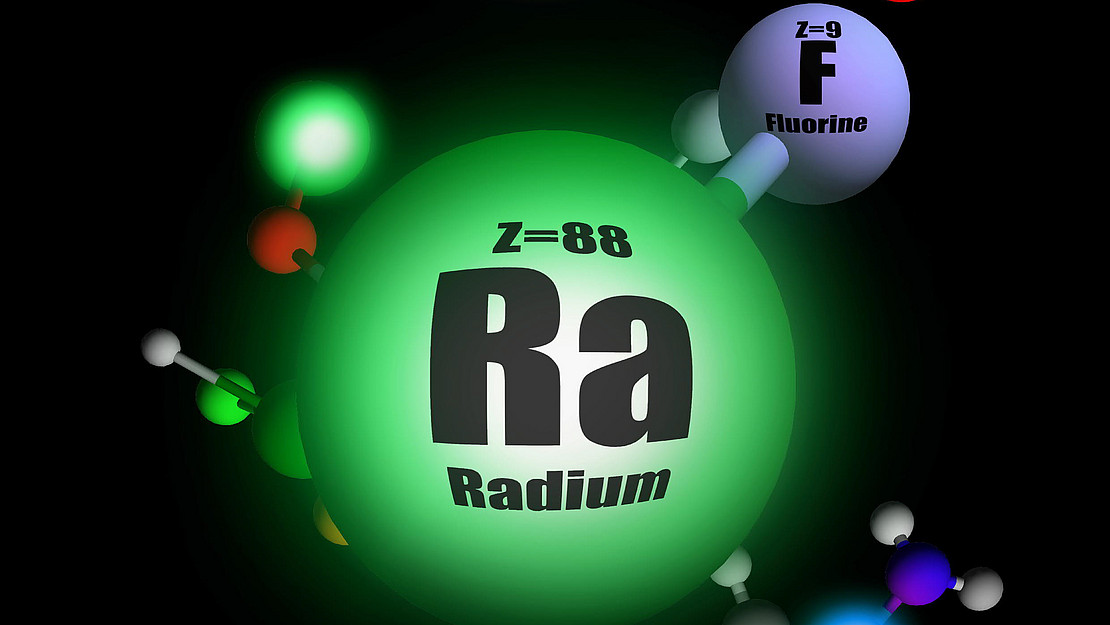This page contains automatically translated content.
Why radium monofluoride can fundamentally change the view of the universe
 Image: garciaruizlab.
Image: garciaruizlab."Physicists are faced with a key observation: if everything in the universe is formed symmetrically, there should be no preferred direction of rotation of the molecular structure, but this is not the case. In living organisms, the structure of various sugar molecules preferentially exhibits a rightward rotation, whereas the structure of amino acid compounds, on the other hand, prefers a leftward rotation," explains Dr. Alexander Breier, a laboratory astrophysicist at the University of Kassel.
Is there a measurable difference between left- and right-handed molecules?
"This is one of the questions we are investigating in Collaborative Research Center (SFB) 1319 ELCH, where we are studying the properties of chiral molecules." Chiral molecules have a mirror image that consists of the same elements but has a different spatial arrangement, comparable to the left and right hand.
Common understanding is that left- and right-handed molecules are energetically the same and that there would be no preferred shape for nature between left and right. However, quantum electrodynamics (QED), a further development of quantum mechanics, predicts a vanishingly small energy difference between left and right, caused by what is known as "parity violation." In particular, chiral molecules are considered suitable sensors for detecting parity violation. According to the calculations of the scientists around the theoretical physicist Prof. Robert Berger from the University of Marburg, this minimal energy effect increases significantly for elements with heavy nuclei, such as radium.
However, radioactive radiation and the short lifetime of radium isotopes make them impossible to study in most laboratories. Berger therefore proposed using the ISOLDE nuclear generation facility at CERN to produce heavy, radioactive molecules for the first time and study them spectroscopically. His idea proved successful.
Using a new methodology, the international team of researchers led by Berger and nuclear physicist Dr. Ronald Ruiz (CERN) succeeded in generating the molecule radium monofluoride (RaF). This molecule has already been predicted to be particularly suitable for laser cooling. This is necessary to study the molecule in precision experiments near absolute temperature zero. This is the only way to measure the minimal energy differences between left and right. Radium monofluoride is not yet a chiral molecule, but it already harbors all the important properties of parity violation and could be the starting point for studies on very cold chiral molecules.
To ensure that the radioactive molecule radium monofluoride was indeed produced in the apparatus in the complex experiment at CERN, Ruiz's research team used molecular spectroscopy, which reveals the individual fingerprint of each molecule. "Since our laboratory astrophysics group here in Kassel has an expertise in diatomic molecules, Ruiz and Berger approached Breier and me," says Prof. Dr. Thomas Giesen, group leader of laboratory astrophysics at the University of Kassel. The team from Kassel, which is conducting joint research with the Marburg scientists in SFB 1319 ELCH, was able to confirm the successful generation of the new molecule radium monofluoride based on the spectroscopic data.
What makes the method so special
Breier is excited about the discovery of the molecule through the methodology used. "The detection methodology is very sensitive: usually1012 to1015 molecules are needed for one to interpret their spectra. For the new methodology, it only takes106, which is a millionth to a billionth of the usual number! " At the same time, Berger and Ruiz said, this has enabled them to develop a method for studying even extremely short-lived radioactive molecules, which live for only a few milliseconds before being destroyed by radioactive decay. "This is a fundamental milestone for physics!" emphasizes Breier. "The possibilities arising from this new method will be of fundamental importance for the study of parity violation on chiral molecules within the SFB 1319 ELCH."
The researchers cannot yet answer the question of where the preference for left-handed or right-handed molecules comes from. But with the ability to study short-lived radium monofluoride, they have found another piece of the puzzle.
The laboratory astrophysics group at the University of Kassel has leading expertise in diatomic molecules and can accurately predict the molecular fingerprint for their unstable isotopologues. One example is the first-ever astronomical detection of the radioactive molecule 26-aluminum monofluoride (26AlF) based on Kassel's predictions, which appeared in the science journal Nature Astronomy under the title "Spectroscopy of short-lived radioactive molecules."
Original article: :
https://www.nature.com/articles/s41586-020-2299-4
Press release from the research network on the topic: https://www.uni-marburg.de/de/aktuelles/news/2020/nature-artikel-radioaktive-molekuele-eignen-sich-als-mini-labore
Contact:
Prof. Dr. Thomas Giesen
University of Kassel
Department of Laboratory Astrophysics
Tel: +49 561 804-4775
E-Mail: t.giesen[at]physik.uni-kassel[dot]de
Dr. Alexander A. Breier
University of Kassel
Department of Laboratory Astrophysics
Tel: +49 561 804-4789
E-Mail: a.breier[at]physik.uni-kassel[dot]de
Website: www.uni-kassel.de\go\labastro